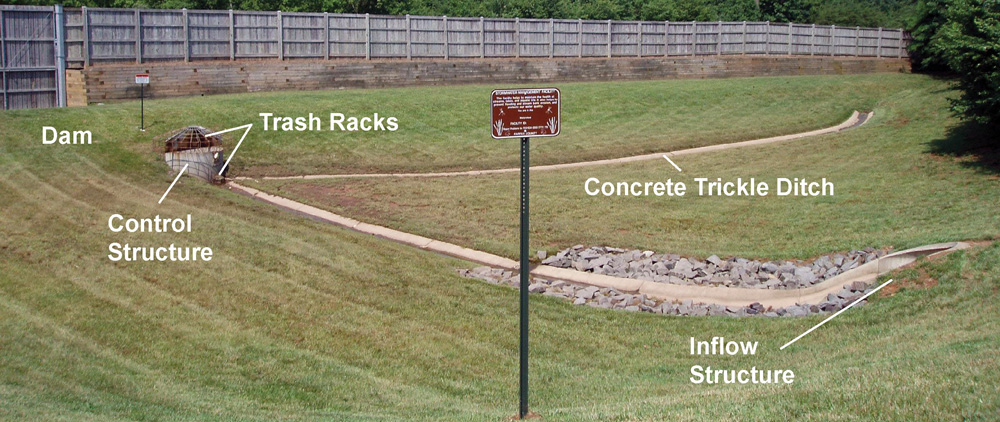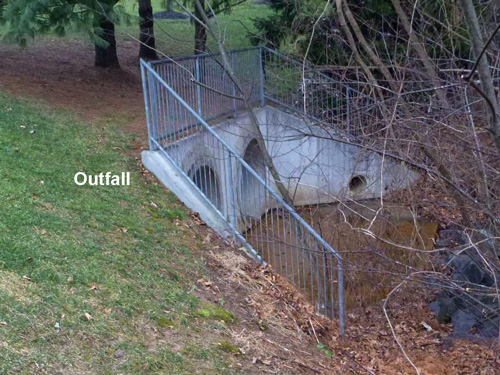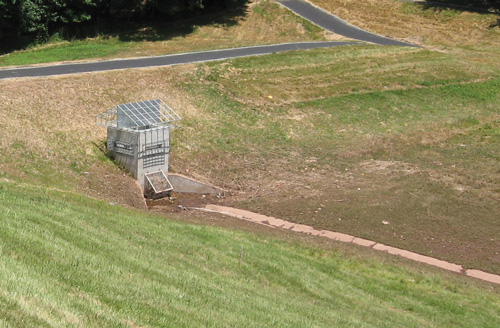 Protecting our environment, one stormwater practice at a time.
Protecting our environment, one stormwater practice at a time.
Wet and Dry Stormwater Management Ponds
Overview
Stormwater management ponds come in many different shapes and sizes, but all have an embankment (dam) to hold back runoff that enters the pond and a control structure that releases the runoff at a rate designed to prevent downstream erosion and flooding. Runoff collects nutrients, sediment, trash, pesticides, oil and grease as it flows over impervious surfaces. Ponds remove much of this pollution by slowing the water and storing it.

How Stormwater Management Ponds Work
 There are three categories of stormwater management ponds: wet ponds, extended detention (dry) ponds and dry ponds.
There are three categories of stormwater management ponds: wet ponds, extended detention (dry) ponds and dry ponds.
Wet ponds have a permanent pool of water. Runoff from each storm enters the pond and partially displaces the water from previous storms. They provide improved water quality and can be used for flood control. The pool prevents re-suspension of sediments and other pollutants deposited during prior storms.
Extended detention (dry) ponds do not hold a permanent pool of water across the pond floor. Runoff is temporarily stored in the extended detention pond floor. They may be enhanced to include micropools at the inflow structure, sediment forebays with permanent pools and deep pools or wetland cells to improve water quality. Extended detention dry ponds provide both water quality and stream protection benefits.
 Dry ponds that are built for volume control do not hold a permanent pool of water on the pond floor. They are designed to reduce peak water flows by temporarily storing runoff on the dry pond floor. Volume-only dry ponds are built for flood control and not for water quality improvements.
Dry ponds that are built for volume control do not hold a permanent pool of water on the pond floor. They are designed to reduce peak water flows by temporarily storing runoff on the dry pond floor. Volume-only dry ponds are built for flood control and not for water quality improvements.
In all ponds, a control structure slowly releases runoff into a downstream channel, allowing trash, sediment and nutrients to settle on the pond floor. The controlled flow rate also reduces erosion of the downstream channel.
Permanent pools in wet ponds and micropools or wetland cells in extended dry ponds achieve biological removal of nutrients. These ponds often incorporate native wetland plant species into the design of the facility as an additional means to filter excess nitrogen.

How to Maintain a Stormwater Management Pond
Without proper maintenance, nutrients such as nitrogen and phosphorus can accumulate in ponds leading to degraded conditions including low dissolved oxygen, algae blooms, unsightly conditions and odors. Excess sediment from upstream erosion can accumulate in the pond which smothers vegetation, blocks structures and reduces the pond’s capacity to hold water.
The dam is damaged or vulnerable to damage when visible seeps, erosion, cave-ins and evidence of animal burrows are observed.
Maintenance is required when:
- Trees and woody vegetation are present on the dam
- Standing water is observed in a dry pond more than 72 hours after a rain event
- A higher than normal water surface elevation is observed in a wet pond more than 72 hours following a rain event
- Structural elements of the pond (including pipes, trash rack, control structure and concrete trickle ditch) are damaged or deteriorated
- Sediment accumulates within the basin
- Excessive algae blooms and/or invasive, aquatic plant species are observed in the basin
FairFacts
- A sediment forebay is a small basin located at the inlet of a pond or other stormwater facility. A forebay is designed as a storage area to trap sediment and pollutants before they enter the main basin, making maintenance easier.
- A wetland cell is an area that is inundated or saturated by surface water or groundwater at a frequency, duration and depth sufficient to support a native wetland plant species adapted to grow in such conditions. Properly designed wetland cells may also provide wildlife habitat.
- Historically, dry ponds were one of the most common stormwater practices in Fairfax County. There are more than 1,900 dry ponds in Fairfax County.
The information in this fact sheet is general in nature and is not intended to determine maintenance responsibility.
For more information, contact:
Department of Public Works and Environmental Services, Maintenance and Stormwater Management Division
10635 West Drive, Fairfax, VA 22030
703-877-2800, TTY 711
ContactMSMD@fairfaxcounty.gov

